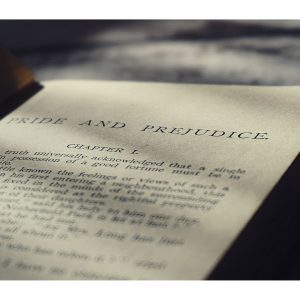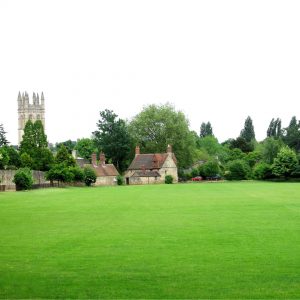We all know there have been amazing works of literature that have been written and enjoyed by millions throughout the years. These stories and authors have originated worldwide and helped expand our viewpoints and the way we see the world. While some force classics upon us, they are classics for a reason and sometimes become some of our most well-loved books.
In the last unit study, we looked at The Hobbit by J.R.R. Tolkien. This time, let’s dive into Georgian and Regency Era England in Pride and Prejudice by Jane Austen. Many the world over love these two classics of British literature. Hopefully, your student will fall in love with them as well. This unit study is best suited for grades 7-12.
Pride and Prejudice Background
Jane Austen wrote and published Pride and Prejudice in 1813, though it was written many years earlier during 1796-1797. During this time, England was ruled by King George III and was experiencing what is now known as the Georgian and Regency Eras. It was a time of political and economic unrest. England was fighting the colonials in America and Napoleon in France, the Industrial Revolution was on its way, their king went mad, and a large portion of English citizens were facing starvation. In this period the expectation of “proper women” were to own only the profession of a wife and lady, Austen bucked tradition and gave us all a peek into the English upper and middle classes through her unique storytelling.
 Jane Austen was born on December 16, 1775, to Reverend George and Cassandra Austen in Steventon, a small village in Hampshire, England. Her father was a clergyman, and her mother was busy raising their eight children. Jane was the 7th of the siblings. With only one other daughter, Cassandra, the two sisters became very close. Once Jane’s formal education at boarding school was complete, she returned home to continue her studies through lessons with her father and extensive reading.
Jane Austen was born on December 16, 1775, to Reverend George and Cassandra Austen in Steventon, a small village in Hampshire, England. Her father was a clergyman, and her mother was busy raising their eight children. Jane was the 7th of the siblings. With only one other daughter, Cassandra, the two sisters became very close. Once Jane’s formal education at boarding school was complete, she returned home to continue her studies through lessons with her father and extensive reading.
Jane and Cassandra both took advantage of the library in their home, and Reverend Austen was quick to supply books and writing supplies to his daughters. It soon became apparent that Jane had a special knack for writing. She would fill notebooks with her stories and read them aloud for her family’s evening amusement and entertainment.
Of Jane Austen’s six novels, the most popular and captivating is Pride and Prejudice. When she first began penning the story, she entitled it First Impressions. After being rejected by a publisher, she spent several years tweaking and editing it before submitting it again. It became her second published work following Sense and Sensibility. She would later complete and publish Mansfield Park, Emma, Northanger Abbey, and Persuasion, with the final two being published posthumously. Because of the impropriety of a woman writing and perhaps also the unrest of the day, no one outside of her family knew Jane was an author. She published anonymously to maintain her and her family’s reputations and anonymity.
When she was around 20 years old, Austen fell in love with a young man named Tom Lefroy. He was considered to be above Jane in rank and station, and though it didn’t matter to them, it greatly mattered to his family. Unfortunately for the couple, Jane was considered to be an unsuitable match and Lefroy was sent away.
In a case of life imitating art, Jane Austen received an offer of marriage in 1802 from a childhood friend named Harris Bigg-Wither. He was a man of means and could offer her a very comfortable living situation. At 27 years old, Jane realized the practicality of the marriage and accepted his proposal. However, the next morning, she changed her mind and called it off. She wasn’t in love with him, and to take a line from Elizabeth Bennet, “I am determined that only the deepest love will induce me into matrimony.” Apparently, this held true for Jane as well.
After suffering from an illness for a year, her health declined to the point that Jane Austen died in July of 1817 at 41 years old. After her death, her brother Henry and sister Cassandra pursued the publishing of her final two works. This is when her name was attached as the author and Jane Austen finally received the credit and notoriety she deserved for her contributions to literature.
Pride and Prejudice is special because of the detail and view of daily life in that time period. And also because it is completely relatable. Her characters are entirely human. Austen was not careful to attack one class while sparing another. She was universal in her criticisms of both the rich, sometimes snobby upper class and the boring, often silly middle class. Her stories include romance, comedy, and sarcasm in a way that makes them enjoyable and entertaining for the masses.
Have a Pride and Prejudice Tea Party
A great way to wrap up this unit study would be to hold a tea party! Your children can invite friends, everyone can dress up, and have a great time pretending to be an Austen character! Turn your kids loose in the kitchen as they whip up these recipes even Lady Catherine de Bourgh would have to enjoy!
- Berry Scones Served with Jam and Clotted Cream:
- Berry Scones: First. preheat oven to 400 degrees. In a bowl, mix 3 cups of flour, 1/3 cup of sugar, 1 tsp of salt, 1 tbsp baking powder, and 1 tsp baking soda. Cut 2/3 cup of cold, unsalted butter into cubes and cut into the dry mixture. Add 1 cup of buttermilk, 1 egg, and 1 tsp vanilla. Then, stir together, but don’t overmix. Turn out the dough onto a solid surface and knead for 2-3 minutes. Add in 1/4 cup of blueberries and 1/4 cup of raspberries (or strawberries), and sprinkle with cinnamon sugar. Fold in the berries and form the dough into a thick circle. Finally, cut the circle into 8 slices, add to a greased pan, and bake for 12 minutes.
- Clotted Cream: For this recipe, you only need one ingredient, but you need three days! That may sound off-putting, but it’s mostly done while you sleep and is worth the effort. You simply need 2 cups of heavy cream, not ultra-pasteurized. Preheat the oven to 170-180 degrees. Pour the cream into a shallow glass baking dish, leaving plenty of room on the sides. Bake in the oven for 12 hours (overnight works great). Carefully remove the dish from the oven, let it cool to room temperature, and refrigerate overnight. The following day, gently skim the cream from the top and leave the thin layer behind. Stir the cream to a smooth texture. If it seems too thick, add a bit of the thin liquid and continue to stir until it reaches your desired consistency. Store the clotted cream in a sealed container in a refrigerator for up to 2 weeks. Enjoy!

- Tea Sandwiches: Sandwiches served at tea must have the crust removed and cut into bite-sized pieces.
- Cucumber Sandwiches: *These taste best served immediately. They get soggy after sitting for a while.* First, spread two bread slices with cream cheese (whipped cream cheese spreads more easily). Then, add thinly sliced English cucumber slices to one slice of bread. Splash with a dash of lemon juice, a sprinkle of salt and pepper, and chives (if desired). Cover with the other slice of bread, cream cheese side down. Finally, remove the crust, and slice the sandwich diagonally twice to make 4 small sandwich triangles.
- Egg Salad Sandwiches: Boil 5 eggs for 10 minutes, then replace the hot water with cold water, and let them cool for 5 minutes. Peel the eggs, and chop them into small pieces. Place the eggs in a mixing bowl with 3 tbsp of mayonnaise, 1 tbsp chopped dill, 1 tsp Dijon mustard, a pinch of salt, and a pinch of pepper. This makes enough for about 3 sandwiches. Cut the crust off the bread and slice the sandwiches in half. For a variation, add lettuce and/or bacon.
- Tea Biscuits: Preheat your oven to 375 degrees. In a large bowl, cream 1 cup of softened butter and 1 1/2 cups of sugar until light and fluffy. Add 3 room temperature eggs one at a time, mixing well after each egg. Beat in 1 tsp vanilla. In a separate bowl, mix 3 cups of all-purpose flour, 2 tsp baking powder, and 1/4 tsp of salt. Gradually add the dry mixture to the other bowl, mixing carefully. The dough will be soft. Drop the dough by tablespoons onto greased baking sheets. Make sure the cookies (biscuits) are about 2 inches apart because they will spread out when cooking. Bake for about 7-8 minutes, until the edges are golden brown. Cool and enjoy!
- Spinach Puffs: Include these delicious puffs for a savory addition to your tea! First, in a skillet over medium heat, add 1 tbsp of oil, 1/3 c. finely chopped onion, and a pinch of salt. Next, cook for about 4-5 minutes until soft. Add 2 cloves of garlic and cook until fragrant, about 30 seconds, then remove from heat. In a mixing bowl, stir together 4 oz. of softened cream cheese and one egg. Stir in the onion-garlic mixture, 1 10 oz package of frozen spinach that has been thawed and as much water squeezed out as possible, 3/4 c. crumbled feta, 2 tbsp fresh chopped dill, 2 tbsp lemon zest, and season with salt and pepper. Grease 9 cups on a muffin tin with cooking spray. Using a lightly floured surface, roll out one puff pastry package until it is a 12″ square. Then, cut the large square into 9 smaller squares and use each one to line a cup on the muffin tin, letting the corners hang over the sides. Add about 2 1/2 tbsp of the filling to each cup and fold the extra pastry to meet in the center and cover the filling. Pinch the pastry tips together, and refrigerate for 30 minutes. While the spinach puffs are chilling, preheat the oven to 400. Remove the puffs from the refrigerator and brush them with a mixture of a beaten egg and a tsp of water. Bake for about 25 minutes – until the pastry is puffed up and golden brown. Lastly, let them cool slightly before lifting them out of the muffin tin. Serve warm or at room temperature.
Pride and Prejudice Learning Videos
A brief view of life at the time Pride and Prejudice was written
Who was Jane Austen? Watch this documentary to find out!
Did you know we aren’t sure what Jane Austen looked like? See how technology helps us get a better idea.
This BBC documentary, Elegance and Decadence, takes a closer look into Regency Era England.
This is part two of the BBC documentary.
The Course Hero YouTube channel has a brief summary and analysis of each chapter of Pride and Prejudice. Watch and compare their thoughts with yours!




